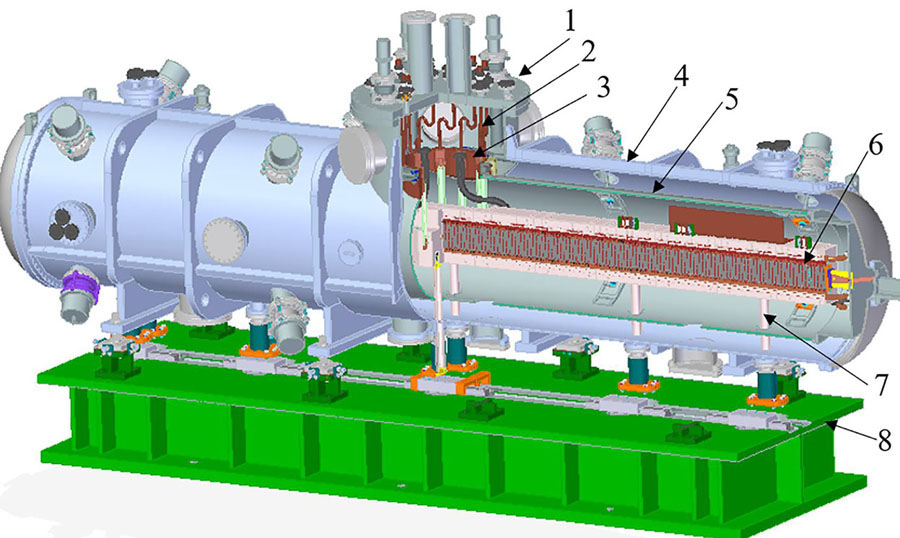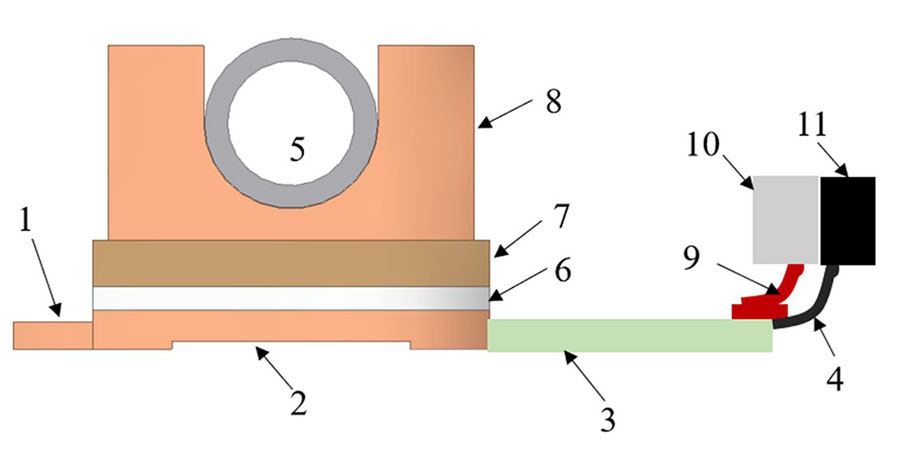Qisheng TANG, Qiaogen ZHOU, Tengma WU, Jidong ZHANG, Kai FAN, Yi DING, Yongmei WEN. Cooling design and test for current leads of SHINE superconducting undulator prototype[J]. NUCLEAR TECHNIQUES, 2022, 45(11): 110101
Search by keywords or author
- NUCLEAR TECHNIQUES
- Vol. 45, Issue 11, 110101 (2022)

Fig. 1. Model of SHINE SCU prototype 1-Flange, 2-Binary current leads, 3-Copper neck, 4-Vacuum chamber, 5-Thermal shield, 6-Magnet, 7-Magnet support rods, 8-Support platform

Fig. 2. Schematic diagram of cooling design for binary current lead1-Normal conductive copper lead, 2-Connecting block, 3-HTS, 4-Superconducting wire, 5-Cooling tube (45 K), 6-AlN block, 7-Copper neck, 8-Thermal conduction copper block, 9-Thermal conduction belt, 10-Magnets fixture (4.2 K), 11-Magnet
Fig. 3. Cooling structure of current lead(a) Structure of thermal conduction assembly, (b) HTS connecting, (c) Copper leads connecting
Fig. 4. Variation curve of thermal conductivity and resistivity of copper (RRR=80)
Fig. 5. Simulation boundary conditions for cooling structure of current lead
Fig. 6. Heat load of copper leads with different diameter
Fig. 7. Temperature distribution of cooling structure of current leads (a) With no current, (b) With full current
Fig. 8. Electric connection of HTS cold end in the cryostat test
Fig. 9. Cooling and powering test for current leads
Fig. 10. Layout of 10 current leads on the copper neck in test
Fig. 11. Temperature curves of HTS hot end during cooling down (a), average temperature comparison of HTS hot end, cooling tube entrance and copper neck (b)
Fig. 12. Temperature curves of HTS hot end during powering up (a), comparison of average temperature of HTS hot end, temperature in cooling tube entrance, and temperature in copper neck (b)
|
Table 1. Main parameters of low-temperature helium gas
| |||||||||||
Table 2. Main simulated temperature of cooling structure of current leads

Set citation alerts for the article
Please enter your email address



